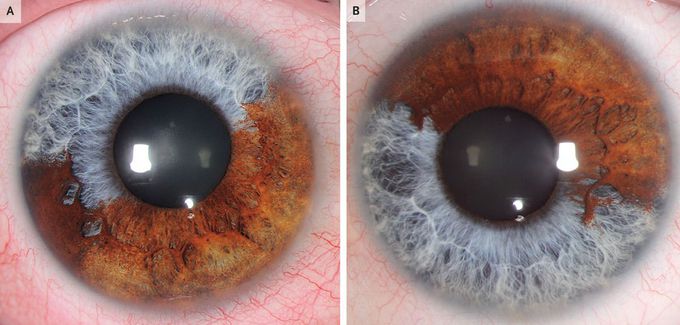


Sectoral Heterochromia
A 43-year-old man presented to the ophthalmology clinic with a 3-month history of redness of the eyelids and was found to have multicolored irises. He reported that his irises had appeared this way since birth. On ophthalmologic examination, the visual acuity was 20/25 in each eye. The iris of the right eye had a blue superior sector and a brown inferior sector (Panel A), and the iris of the left eye had an inverse color pattern (Panel B). A chalazion was present on the left upper eyelid. The remainder of the examination was normal. A diagnosis of congenital sectoral heterochromia was made. Heterochromia is a difference in color between a person’s two irises. Heterochromia can be complete (meaning that each iris is a single color that is different from the other) or sectoral (meaning that each iris consists of more than one color). Congenital heterochromia may be an isolated, benign finding or may be associated with an inherited syndrome. In this case, the patient had a family history of heterochromia and deafness in several first-degree family members, although he reported having no hearing problems. Referrals for audiometry and genetic testing were made owing to concern about a possible genetic condition. Warm compresses were recommended for the management of the chalazion. Sadiq Said, M.D. Frank Blaser, M.D. University Hospital Zurich, Zurich, Switzerland source:nejm.org
Acute Conjunctivitis (Pink Eye) | Allergic, Bacterial, Viral | Symptoms, Diagnosis, TreatmentWhat causes eye freckles? Are they dangerous?Strabismus: Everything You Need To KnowFATTY DEPOSITS of CHOLESTEROL around EYES | How to get rid of it?-Dr.Rajdeep Mysore|Doctors' CircleGlaucomaApical cystectomyMandibular deviation following Hemimandibulectomy

